Health of the Older Adult: New Zealand Aged Care Policies Report
VerifiedAdded on 2021/10/07
|14
|3615
|73
Report
AI Summary
This report delves into the health of older adults, focusing on New Zealand's aged care policies and life expectancy. It begins with an introduction to aging and aged care, emphasizing the increasing need for these services. The report then analyzes New Zealand's data on life expectancy, morbidity, ...

Running head: HEALTH OF THE OLDER ADULT
Health of the Older Adult
Name of the Student
Name of the University
Author Note
Health of the Older Adult
Name of the Student
Name of the University
Author Note
Paraphrase This Document
Need a fresh take? Get an instant paraphrase of this document with our AI Paraphraser
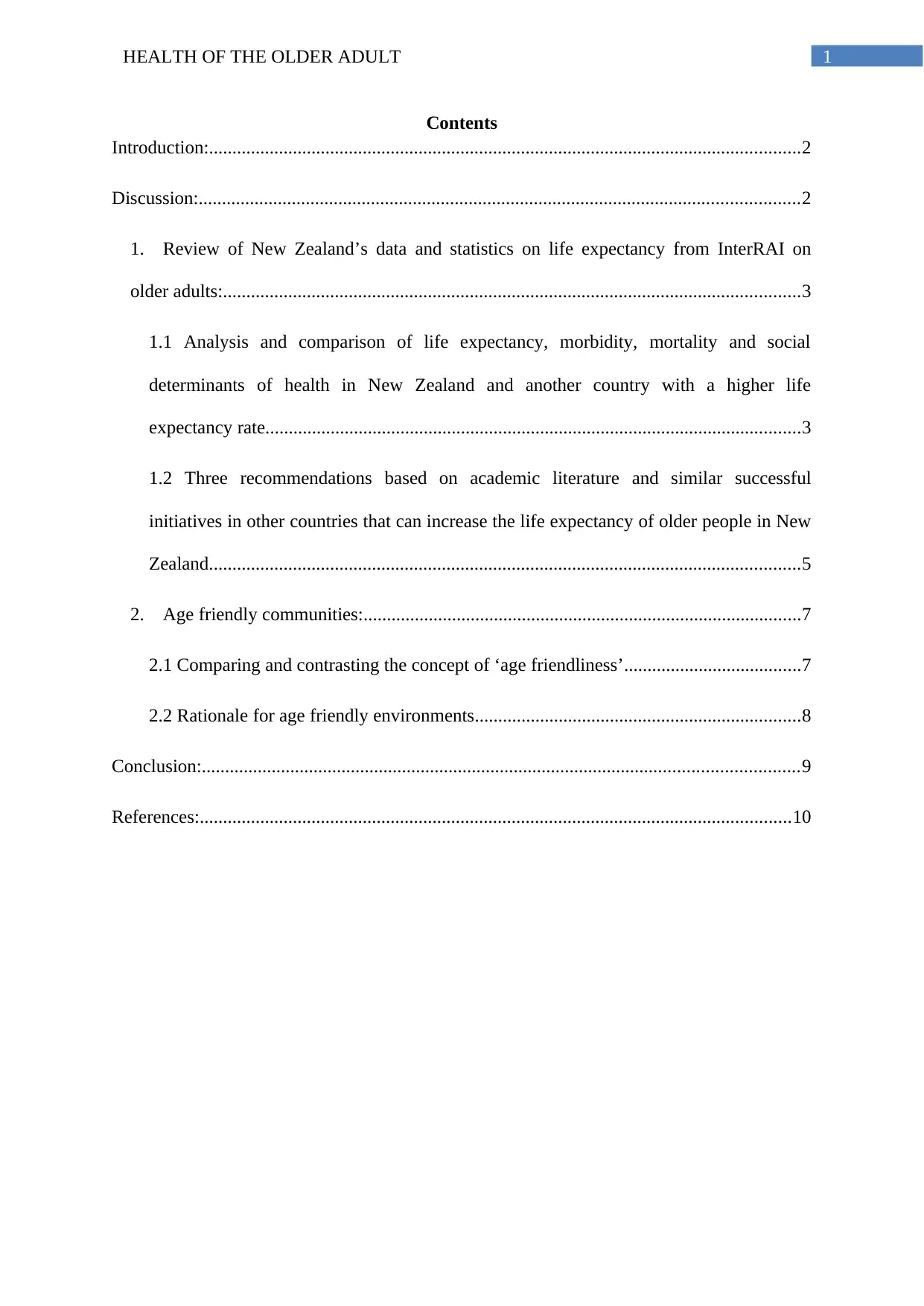
1HEALTH OF THE OLDER ADULT
Contents
Introduction:...............................................................................................................................2
Discussion:.................................................................................................................................2
1. Review of New Zealand’s data and statistics on life expectancy from InterRAI on
older adults:............................................................................................................................3
1.1 Analysis and comparison of life expectancy, morbidity, mortality and social
determinants of health in New Zealand and another country with a higher life
expectancy rate...................................................................................................................3
1.2 Three recommendations based on academic literature and similar successful
initiatives in other countries that can increase the life expectancy of older people in New
Zealand...............................................................................................................................5
2. Age friendly communities:..............................................................................................7
2.1 Comparing and contrasting the concept of ‘age friendliness’......................................7
2.2 Rationale for age friendly environments......................................................................8
Conclusion:................................................................................................................................9
References:...............................................................................................................................10
Contents
Introduction:...............................................................................................................................2
Discussion:.................................................................................................................................2
1. Review of New Zealand’s data and statistics on life expectancy from InterRAI on
older adults:............................................................................................................................3
1.1 Analysis and comparison of life expectancy, morbidity, mortality and social
determinants of health in New Zealand and another country with a higher life
expectancy rate...................................................................................................................3
1.2 Three recommendations based on academic literature and similar successful
initiatives in other countries that can increase the life expectancy of older people in New
Zealand...............................................................................................................................5
2. Age friendly communities:..............................................................................................7
2.1 Comparing and contrasting the concept of ‘age friendliness’......................................7
2.2 Rationale for age friendly environments......................................................................8
Conclusion:................................................................................................................................9
References:...............................................................................................................................10
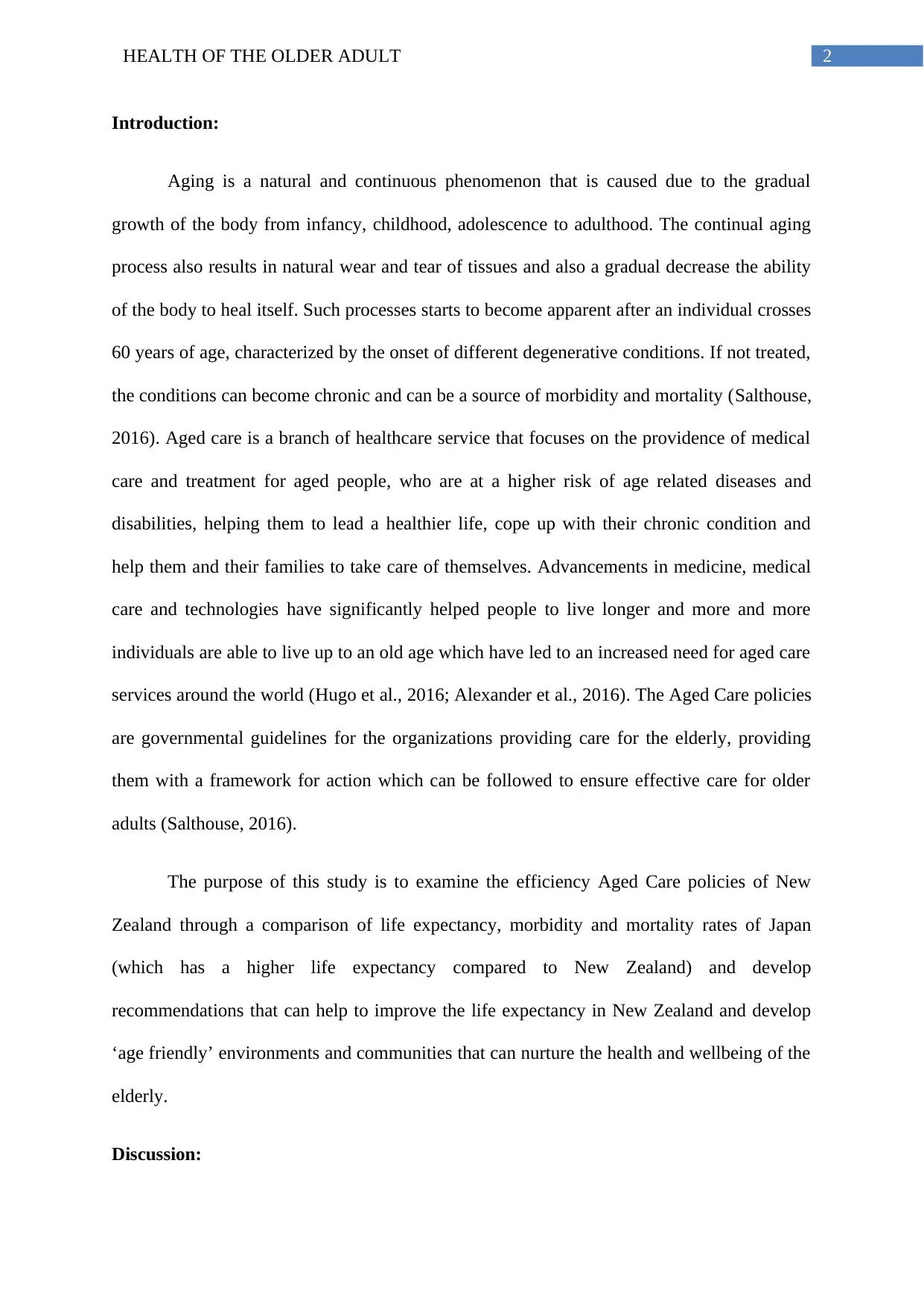
2HEALTH OF THE OLDER ADULT
Introduction:
Aging is a natural and continuous phenomenon that is caused due to the gradual
growth of the body from infancy, childhood, adolescence to adulthood. The continual aging
process also results in natural wear and tear of tissues and also a gradual decrease the ability
of the body to heal itself. Such processes starts to become apparent after an individual crosses
60 years of age, characterized by the onset of different degenerative conditions. If not treated,
the conditions can become chronic and can be a source of morbidity and mortality (Salthouse,
2016). Aged care is a branch of healthcare service that focuses on the providence of medical
care and treatment for aged people, who are at a higher risk of age related diseases and
disabilities, helping them to lead a healthier life, cope up with their chronic condition and
help them and their families to take care of themselves. Advancements in medicine, medical
care and technologies have significantly helped people to live longer and more and more
individuals are able to live up to an old age which have led to an increased need for aged care
services around the world (Hugo et al., 2016; Alexander et al., 2016). The Aged Care policies
are governmental guidelines for the organizations providing care for the elderly, providing
them with a framework for action which can be followed to ensure effective care for older
adults (Salthouse, 2016).
The purpose of this study is to examine the efficiency Aged Care policies of New
Zealand through a comparison of life expectancy, morbidity and mortality rates of Japan
(which has a higher life expectancy compared to New Zealand) and develop
recommendations that can help to improve the life expectancy in New Zealand and develop
‘age friendly’ environments and communities that can nurture the health and wellbeing of the
elderly.
Discussion:
Introduction:
Aging is a natural and continuous phenomenon that is caused due to the gradual
growth of the body from infancy, childhood, adolescence to adulthood. The continual aging
process also results in natural wear and tear of tissues and also a gradual decrease the ability
of the body to heal itself. Such processes starts to become apparent after an individual crosses
60 years of age, characterized by the onset of different degenerative conditions. If not treated,
the conditions can become chronic and can be a source of morbidity and mortality (Salthouse,
2016). Aged care is a branch of healthcare service that focuses on the providence of medical
care and treatment for aged people, who are at a higher risk of age related diseases and
disabilities, helping them to lead a healthier life, cope up with their chronic condition and
help them and their families to take care of themselves. Advancements in medicine, medical
care and technologies have significantly helped people to live longer and more and more
individuals are able to live up to an old age which have led to an increased need for aged care
services around the world (Hugo et al., 2016; Alexander et al., 2016). The Aged Care policies
are governmental guidelines for the organizations providing care for the elderly, providing
them with a framework for action which can be followed to ensure effective care for older
adults (Salthouse, 2016).
The purpose of this study is to examine the efficiency Aged Care policies of New
Zealand through a comparison of life expectancy, morbidity and mortality rates of Japan
(which has a higher life expectancy compared to New Zealand) and develop
recommendations that can help to improve the life expectancy in New Zealand and develop
‘age friendly’ environments and communities that can nurture the health and wellbeing of the
elderly.
Discussion:
⊘ This is a preview!⊘
Do you want full access?
Subscribe today to unlock all pages.

Trusted by 1+ million students worldwide
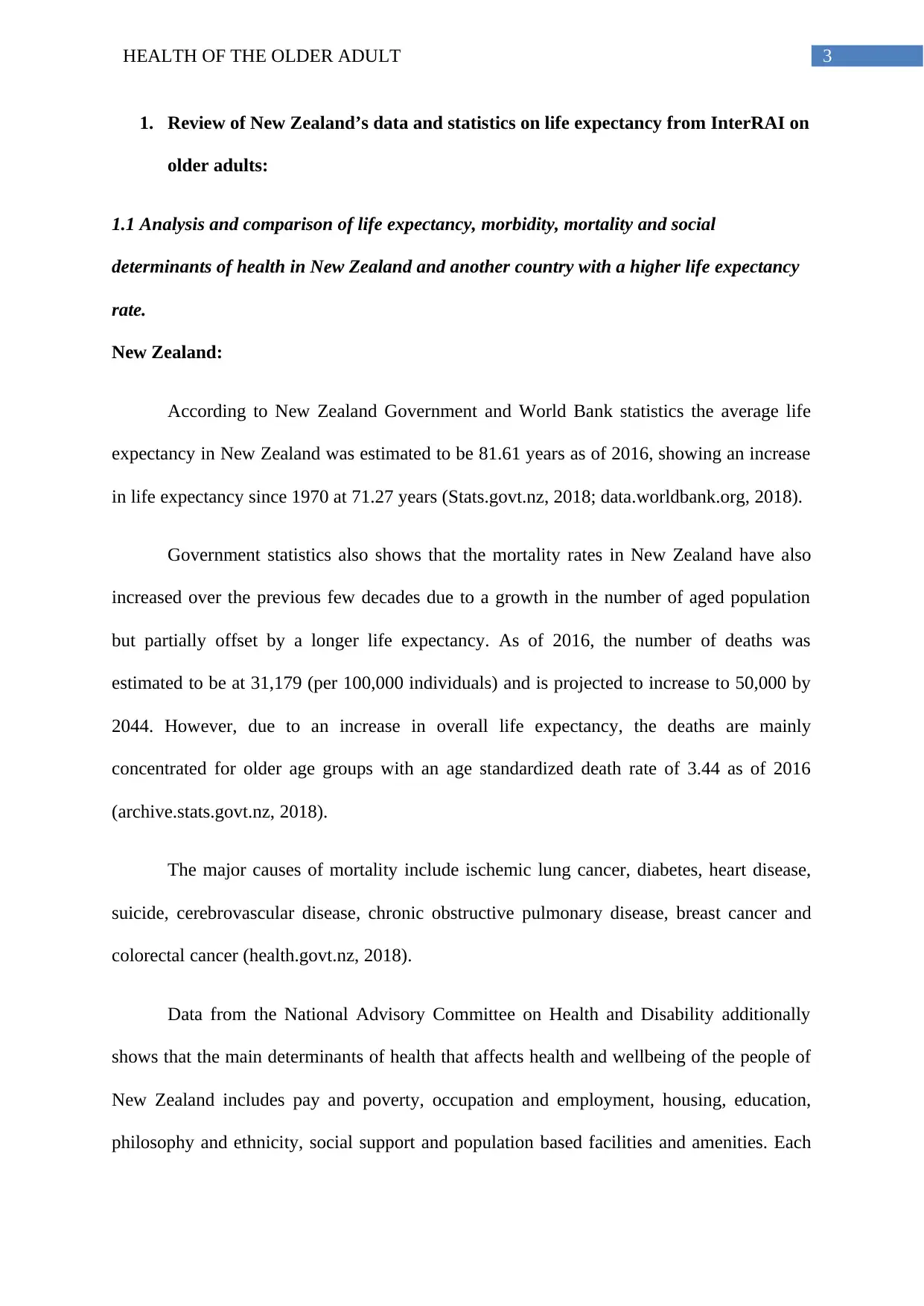
3HEALTH OF THE OLDER ADULT
1. Review of New Zealand’s data and statistics on life expectancy from InterRAI on
older adults:
1.1 Analysis and comparison of life expectancy, morbidity, mortality and social
determinants of health in New Zealand and another country with a higher life expectancy
rate.
New Zealand:
According to New Zealand Government and World Bank statistics the average life
expectancy in New Zealand was estimated to be 81.61 years as of 2016, showing an increase
in life expectancy since 1970 at 71.27 years (Stats.govt.nz, 2018; data.worldbank.org, 2018).
Government statistics also shows that the mortality rates in New Zealand have also
increased over the previous few decades due to a growth in the number of aged population
but partially offset by a longer life expectancy. As of 2016, the number of deaths was
estimated to be at 31,179 (per 100,000 individuals) and is projected to increase to 50,000 by
2044. However, due to an increase in overall life expectancy, the deaths are mainly
concentrated for older age groups with an age standardized death rate of 3.44 as of 2016
(archive.stats.govt.nz, 2018).
The major causes of mortality include ischemic lung cancer, diabetes, heart disease,
suicide, cerebrovascular disease, chronic obstructive pulmonary disease, breast cancer and
colorectal cancer (health.govt.nz, 2018).
Data from the National Advisory Committee on Health and Disability additionally
shows that the main determinants of health that affects health and wellbeing of the people of
New Zealand includes pay and poverty, occupation and employment, housing, education,
philosophy and ethnicity, social support and population based facilities and amenities. Each
1. Review of New Zealand’s data and statistics on life expectancy from InterRAI on
older adults:
1.1 Analysis and comparison of life expectancy, morbidity, mortality and social
determinants of health in New Zealand and another country with a higher life expectancy
rate.
New Zealand:
According to New Zealand Government and World Bank statistics the average life
expectancy in New Zealand was estimated to be 81.61 years as of 2016, showing an increase
in life expectancy since 1970 at 71.27 years (Stats.govt.nz, 2018; data.worldbank.org, 2018).
Government statistics also shows that the mortality rates in New Zealand have also
increased over the previous few decades due to a growth in the number of aged population
but partially offset by a longer life expectancy. As of 2016, the number of deaths was
estimated to be at 31,179 (per 100,000 individuals) and is projected to increase to 50,000 by
2044. However, due to an increase in overall life expectancy, the deaths are mainly
concentrated for older age groups with an age standardized death rate of 3.44 as of 2016
(archive.stats.govt.nz, 2018).
The major causes of mortality include ischemic lung cancer, diabetes, heart disease,
suicide, cerebrovascular disease, chronic obstructive pulmonary disease, breast cancer and
colorectal cancer (health.govt.nz, 2018).
Data from the National Advisory Committee on Health and Disability additionally
shows that the main determinants of health that affects health and wellbeing of the people of
New Zealand includes pay and poverty, occupation and employment, housing, education,
philosophy and ethnicity, social support and population based facilities and amenities. Each
Paraphrase This Document
Need a fresh take? Get an instant paraphrase of this document with our AI Paraphraser
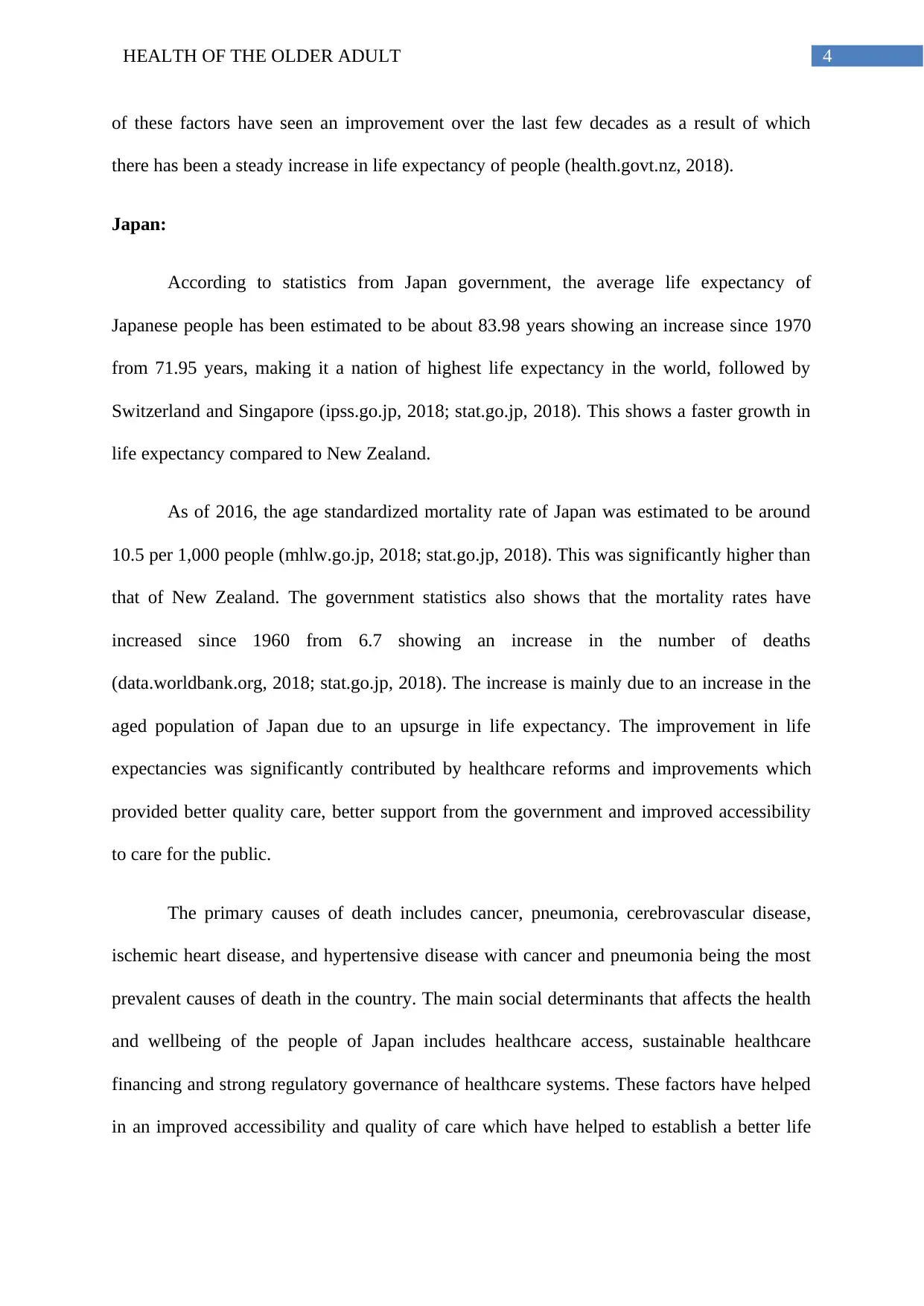
4HEALTH OF THE OLDER ADULT
of these factors have seen an improvement over the last few decades as a result of which
there has been a steady increase in life expectancy of people (health.govt.nz, 2018).
Japan:
According to statistics from Japan government, the average life expectancy of
Japanese people has been estimated to be about 83.98 years showing an increase since 1970
from 71.95 years, making it a nation of highest life expectancy in the world, followed by
Switzerland and Singapore (ipss.go.jp, 2018; stat.go.jp, 2018). This shows a faster growth in
life expectancy compared to New Zealand.
As of 2016, the age standardized mortality rate of Japan was estimated to be around
10.5 per 1,000 people (mhlw.go.jp, 2018; stat.go.jp, 2018). This was significantly higher than
that of New Zealand. The government statistics also shows that the mortality rates have
increased since 1960 from 6.7 showing an increase in the number of deaths
(data.worldbank.org, 2018; stat.go.jp, 2018). The increase is mainly due to an increase in the
aged population of Japan due to an upsurge in life expectancy. The improvement in life
expectancies was significantly contributed by healthcare reforms and improvements which
provided better quality care, better support from the government and improved accessibility
to care for the public.
The primary causes of death includes cancer, pneumonia, cerebrovascular disease,
ischemic heart disease, and hypertensive disease with cancer and pneumonia being the most
prevalent causes of death in the country. The main social determinants that affects the health
and wellbeing of the people of Japan includes healthcare access, sustainable healthcare
financing and strong regulatory governance of healthcare systems. These factors have helped
in an improved accessibility and quality of care which have helped to establish a better life
of these factors have seen an improvement over the last few decades as a result of which
there has been a steady increase in life expectancy of people (health.govt.nz, 2018).
Japan:
According to statistics from Japan government, the average life expectancy of
Japanese people has been estimated to be about 83.98 years showing an increase since 1970
from 71.95 years, making it a nation of highest life expectancy in the world, followed by
Switzerland and Singapore (ipss.go.jp, 2018; stat.go.jp, 2018). This shows a faster growth in
life expectancy compared to New Zealand.
As of 2016, the age standardized mortality rate of Japan was estimated to be around
10.5 per 1,000 people (mhlw.go.jp, 2018; stat.go.jp, 2018). This was significantly higher than
that of New Zealand. The government statistics also shows that the mortality rates have
increased since 1960 from 6.7 showing an increase in the number of deaths
(data.worldbank.org, 2018; stat.go.jp, 2018). The increase is mainly due to an increase in the
aged population of Japan due to an upsurge in life expectancy. The improvement in life
expectancies was significantly contributed by healthcare reforms and improvements which
provided better quality care, better support from the government and improved accessibility
to care for the public.
The primary causes of death includes cancer, pneumonia, cerebrovascular disease,
ischemic heart disease, and hypertensive disease with cancer and pneumonia being the most
prevalent causes of death in the country. The main social determinants that affects the health
and wellbeing of the people of Japan includes healthcare access, sustainable healthcare
financing and strong regulatory governance of healthcare systems. These factors have helped
in an improved accessibility and quality of care which have helped to establish a better life
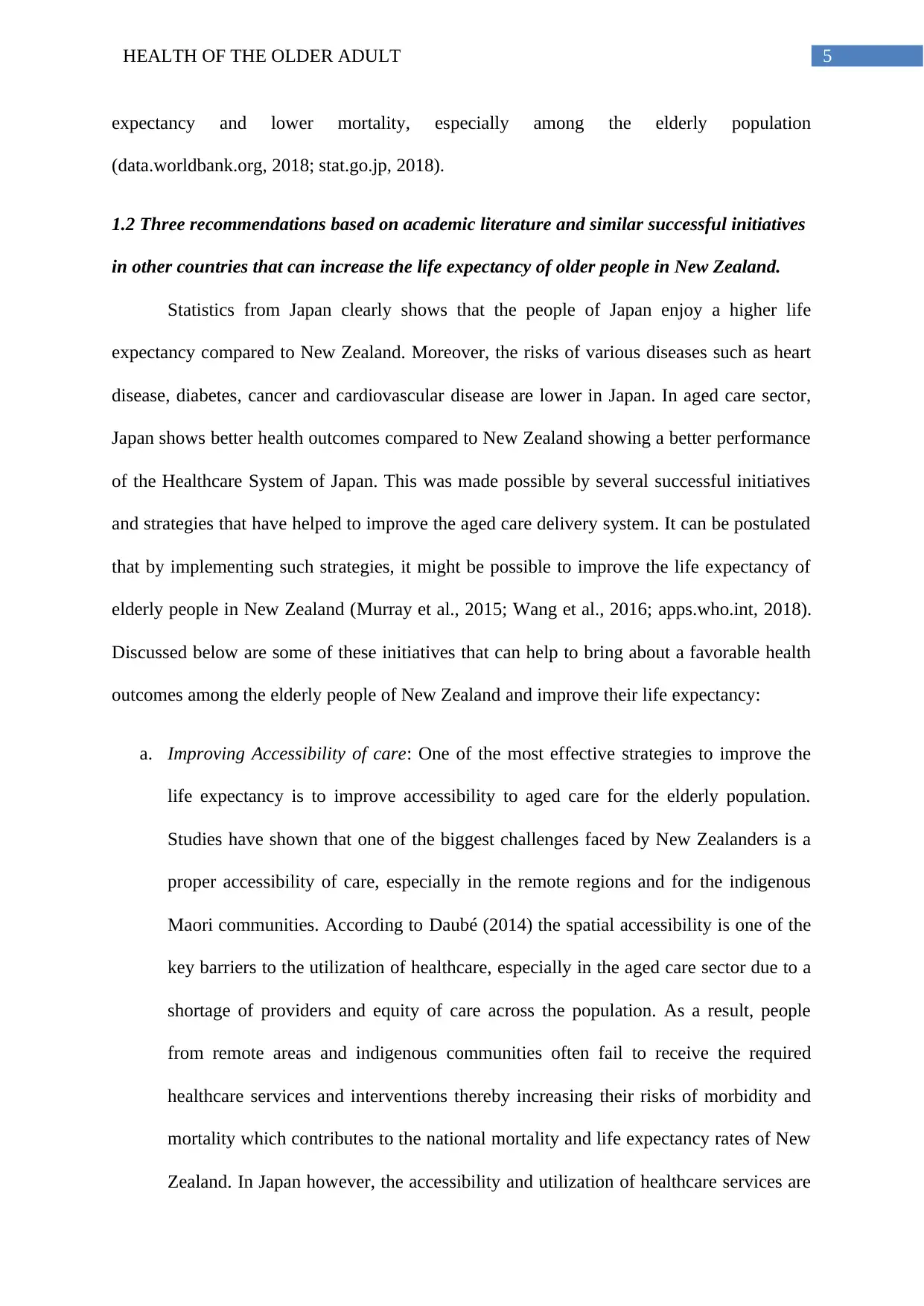
5HEALTH OF THE OLDER ADULT
expectancy and lower mortality, especially among the elderly population
(data.worldbank.org, 2018; stat.go.jp, 2018).
1.2 Three recommendations based on academic literature and similar successful initiatives
in other countries that can increase the life expectancy of older people in New Zealand.
Statistics from Japan clearly shows that the people of Japan enjoy a higher life
expectancy compared to New Zealand. Moreover, the risks of various diseases such as heart
disease, diabetes, cancer and cardiovascular disease are lower in Japan. In aged care sector,
Japan shows better health outcomes compared to New Zealand showing a better performance
of the Healthcare System of Japan. This was made possible by several successful initiatives
and strategies that have helped to improve the aged care delivery system. It can be postulated
that by implementing such strategies, it might be possible to improve the life expectancy of
elderly people in New Zealand (Murray et al., 2015; Wang et al., 2016; apps.who.int, 2018).
Discussed below are some of these initiatives that can help to bring about a favorable health
outcomes among the elderly people of New Zealand and improve their life expectancy:
a. Improving Accessibility of care: One of the most effective strategies to improve the
life expectancy is to improve accessibility to aged care for the elderly population.
Studies have shown that one of the biggest challenges faced by New Zealanders is a
proper accessibility of care, especially in the remote regions and for the indigenous
Maori communities. According to Daubé (2014) the spatial accessibility is one of the
key barriers to the utilization of healthcare, especially in the aged care sector due to a
shortage of providers and equity of care across the population. As a result, people
from remote areas and indigenous communities often fail to receive the required
healthcare services and interventions thereby increasing their risks of morbidity and
mortality which contributes to the national mortality and life expectancy rates of New
Zealand. In Japan however, the accessibility and utilization of healthcare services are
expectancy and lower mortality, especially among the elderly population
(data.worldbank.org, 2018; stat.go.jp, 2018).
1.2 Three recommendations based on academic literature and similar successful initiatives
in other countries that can increase the life expectancy of older people in New Zealand.
Statistics from Japan clearly shows that the people of Japan enjoy a higher life
expectancy compared to New Zealand. Moreover, the risks of various diseases such as heart
disease, diabetes, cancer and cardiovascular disease are lower in Japan. In aged care sector,
Japan shows better health outcomes compared to New Zealand showing a better performance
of the Healthcare System of Japan. This was made possible by several successful initiatives
and strategies that have helped to improve the aged care delivery system. It can be postulated
that by implementing such strategies, it might be possible to improve the life expectancy of
elderly people in New Zealand (Murray et al., 2015; Wang et al., 2016; apps.who.int, 2018).
Discussed below are some of these initiatives that can help to bring about a favorable health
outcomes among the elderly people of New Zealand and improve their life expectancy:
a. Improving Accessibility of care: One of the most effective strategies to improve the
life expectancy is to improve accessibility to aged care for the elderly population.
Studies have shown that one of the biggest challenges faced by New Zealanders is a
proper accessibility of care, especially in the remote regions and for the indigenous
Maori communities. According to Daubé (2014) the spatial accessibility is one of the
key barriers to the utilization of healthcare, especially in the aged care sector due to a
shortage of providers and equity of care across the population. As a result, people
from remote areas and indigenous communities often fail to receive the required
healthcare services and interventions thereby increasing their risks of morbidity and
mortality which contributes to the national mortality and life expectancy rates of New
Zealand. In Japan however, the accessibility and utilization of healthcare services are
⊘ This is a preview!⊘
Do you want full access?
Subscribe today to unlock all pages.

Trusted by 1+ million students worldwide
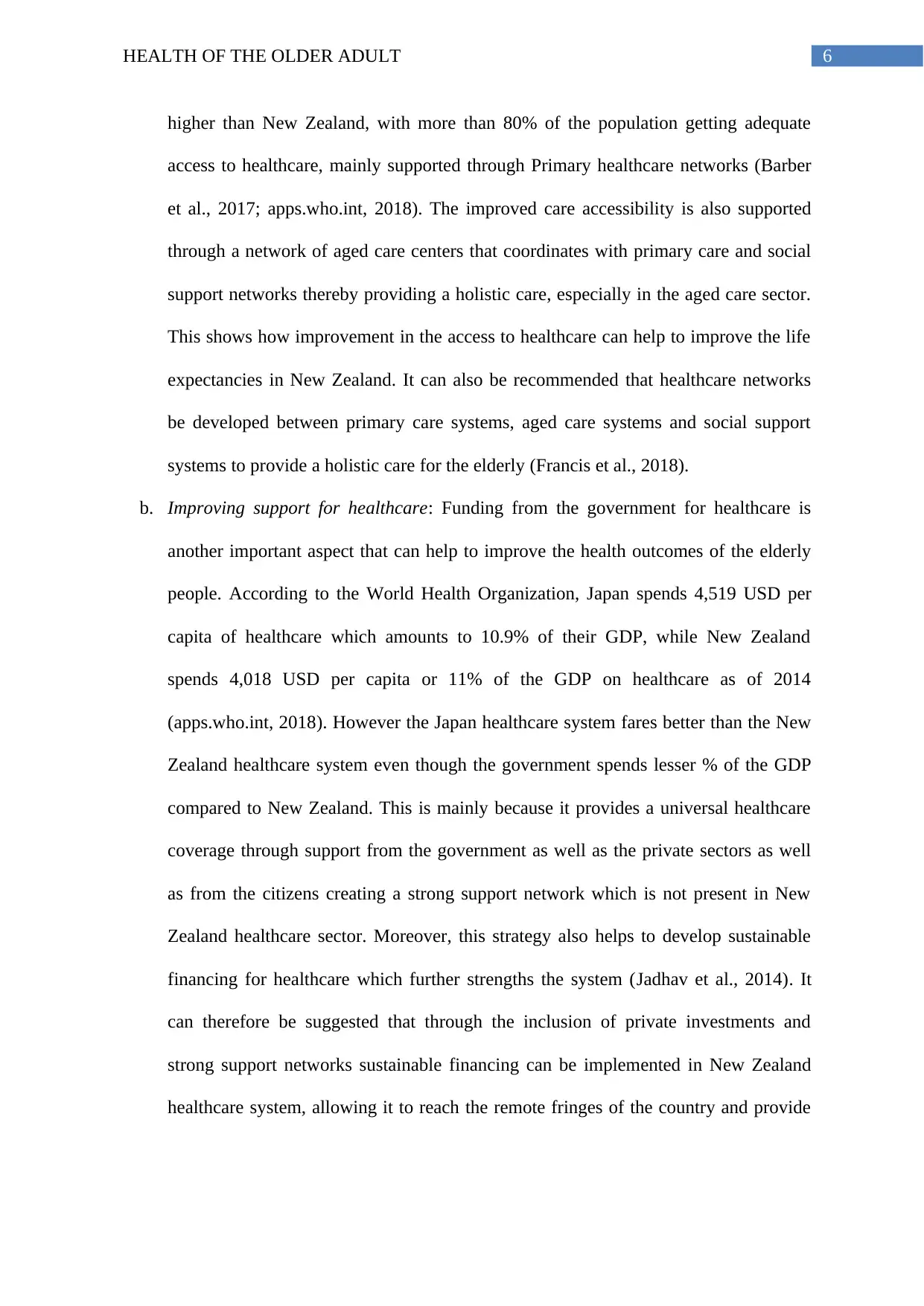
6HEALTH OF THE OLDER ADULT
higher than New Zealand, with more than 80% of the population getting adequate
access to healthcare, mainly supported through Primary healthcare networks (Barber
et al., 2017; apps.who.int, 2018). The improved care accessibility is also supported
through a network of aged care centers that coordinates with primary care and social
support networks thereby providing a holistic care, especially in the aged care sector.
This shows how improvement in the access to healthcare can help to improve the life
expectancies in New Zealand. It can also be recommended that healthcare networks
be developed between primary care systems, aged care systems and social support
systems to provide a holistic care for the elderly (Francis et al., 2018).
b. Improving support for healthcare: Funding from the government for healthcare is
another important aspect that can help to improve the health outcomes of the elderly
people. According to the World Health Organization, Japan spends 4,519 USD per
capita of healthcare which amounts to 10.9% of their GDP, while New Zealand
spends 4,018 USD per capita or 11% of the GDP on healthcare as of 2014
(apps.who.int, 2018). However the Japan healthcare system fares better than the New
Zealand healthcare system even though the government spends lesser % of the GDP
compared to New Zealand. This is mainly because it provides a universal healthcare
coverage through support from the government as well as the private sectors as well
as from the citizens creating a strong support network which is not present in New
Zealand healthcare sector. Moreover, this strategy also helps to develop sustainable
financing for healthcare which further strengths the system (Jadhav et al., 2014). It
can therefore be suggested that through the inclusion of private investments and
strong support networks sustainable financing can be implemented in New Zealand
healthcare system, allowing it to reach the remote fringes of the country and provide
higher than New Zealand, with more than 80% of the population getting adequate
access to healthcare, mainly supported through Primary healthcare networks (Barber
et al., 2017; apps.who.int, 2018). The improved care accessibility is also supported
through a network of aged care centers that coordinates with primary care and social
support networks thereby providing a holistic care, especially in the aged care sector.
This shows how improvement in the access to healthcare can help to improve the life
expectancies in New Zealand. It can also be recommended that healthcare networks
be developed between primary care systems, aged care systems and social support
systems to provide a holistic care for the elderly (Francis et al., 2018).
b. Improving support for healthcare: Funding from the government for healthcare is
another important aspect that can help to improve the health outcomes of the elderly
people. According to the World Health Organization, Japan spends 4,519 USD per
capita of healthcare which amounts to 10.9% of their GDP, while New Zealand
spends 4,018 USD per capita or 11% of the GDP on healthcare as of 2014
(apps.who.int, 2018). However the Japan healthcare system fares better than the New
Zealand healthcare system even though the government spends lesser % of the GDP
compared to New Zealand. This is mainly because it provides a universal healthcare
coverage through support from the government as well as the private sectors as well
as from the citizens creating a strong support network which is not present in New
Zealand healthcare sector. Moreover, this strategy also helps to develop sustainable
financing for healthcare which further strengths the system (Jadhav et al., 2014). It
can therefore be suggested that through the inclusion of private investments and
strong support networks sustainable financing can be implemented in New Zealand
healthcare system, allowing it to reach the remote fringes of the country and provide
Paraphrase This Document
Need a fresh take? Get an instant paraphrase of this document with our AI Paraphraser
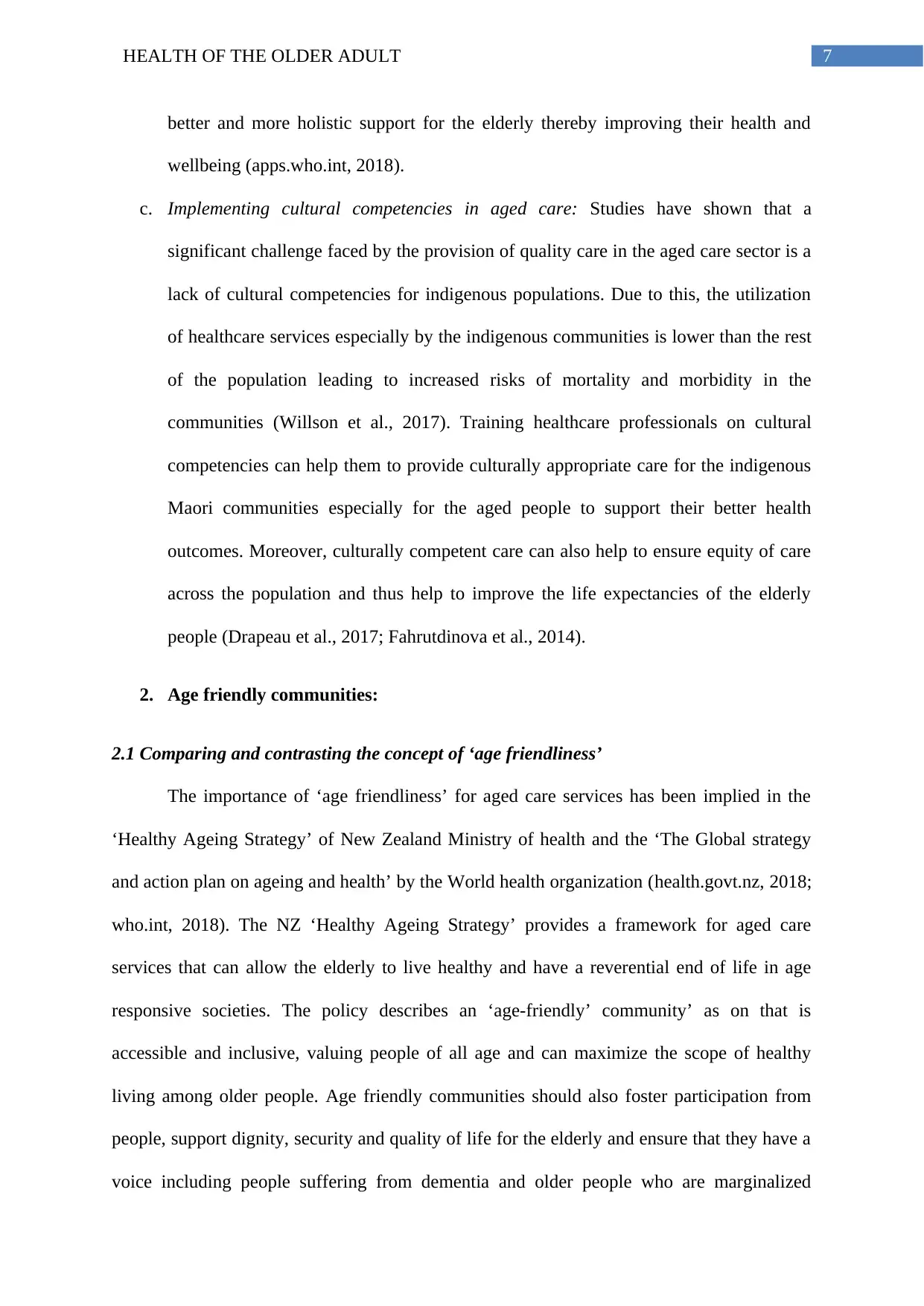
7HEALTH OF THE OLDER ADULT
better and more holistic support for the elderly thereby improving their health and
wellbeing (apps.who.int, 2018).
c. Implementing cultural competencies in aged care: Studies have shown that a
significant challenge faced by the provision of quality care in the aged care sector is a
lack of cultural competencies for indigenous populations. Due to this, the utilization
of healthcare services especially by the indigenous communities is lower than the rest
of the population leading to increased risks of mortality and morbidity in the
communities (Willson et al., 2017). Training healthcare professionals on cultural
competencies can help them to provide culturally appropriate care for the indigenous
Maori communities especially for the aged people to support their better health
outcomes. Moreover, culturally competent care can also help to ensure equity of care
across the population and thus help to improve the life expectancies of the elderly
people (Drapeau et al., 2017; Fahrutdinova et al., 2014).
2. Age friendly communities:
2.1 Comparing and contrasting the concept of ‘age friendliness’
The importance of ‘age friendliness’ for aged care services has been implied in the
‘Healthy Ageing Strategy’ of New Zealand Ministry of health and the ‘The Global strategy
and action plan on ageing and health’ by the World health organization (health.govt.nz, 2018;
who.int, 2018). The NZ ‘Healthy Ageing Strategy’ provides a framework for aged care
services that can allow the elderly to live healthy and have a reverential end of life in age
responsive societies. The policy describes an ‘age-friendly’ community’ as on that is
accessible and inclusive, valuing people of all age and can maximize the scope of healthy
living among older people. Age friendly communities should also foster participation from
people, support dignity, security and quality of life for the elderly and ensure that they have a
voice including people suffering from dementia and older people who are marginalized
better and more holistic support for the elderly thereby improving their health and
wellbeing (apps.who.int, 2018).
c. Implementing cultural competencies in aged care: Studies have shown that a
significant challenge faced by the provision of quality care in the aged care sector is a
lack of cultural competencies for indigenous populations. Due to this, the utilization
of healthcare services especially by the indigenous communities is lower than the rest
of the population leading to increased risks of mortality and morbidity in the
communities (Willson et al., 2017). Training healthcare professionals on cultural
competencies can help them to provide culturally appropriate care for the indigenous
Maori communities especially for the aged people to support their better health
outcomes. Moreover, culturally competent care can also help to ensure equity of care
across the population and thus help to improve the life expectancies of the elderly
people (Drapeau et al., 2017; Fahrutdinova et al., 2014).
2. Age friendly communities:
2.1 Comparing and contrasting the concept of ‘age friendliness’
The importance of ‘age friendliness’ for aged care services has been implied in the
‘Healthy Ageing Strategy’ of New Zealand Ministry of health and the ‘The Global strategy
and action plan on ageing and health’ by the World health organization (health.govt.nz, 2018;
who.int, 2018). The NZ ‘Healthy Ageing Strategy’ provides a framework for aged care
services that can allow the elderly to live healthy and have a reverential end of life in age
responsive societies. The policy describes an ‘age-friendly’ community’ as on that is
accessible and inclusive, valuing people of all age and can maximize the scope of healthy
living among older people. Age friendly communities should also foster participation from
people, support dignity, security and quality of life for the elderly and ensure that they have a
voice including people suffering from dementia and older people who are marginalized
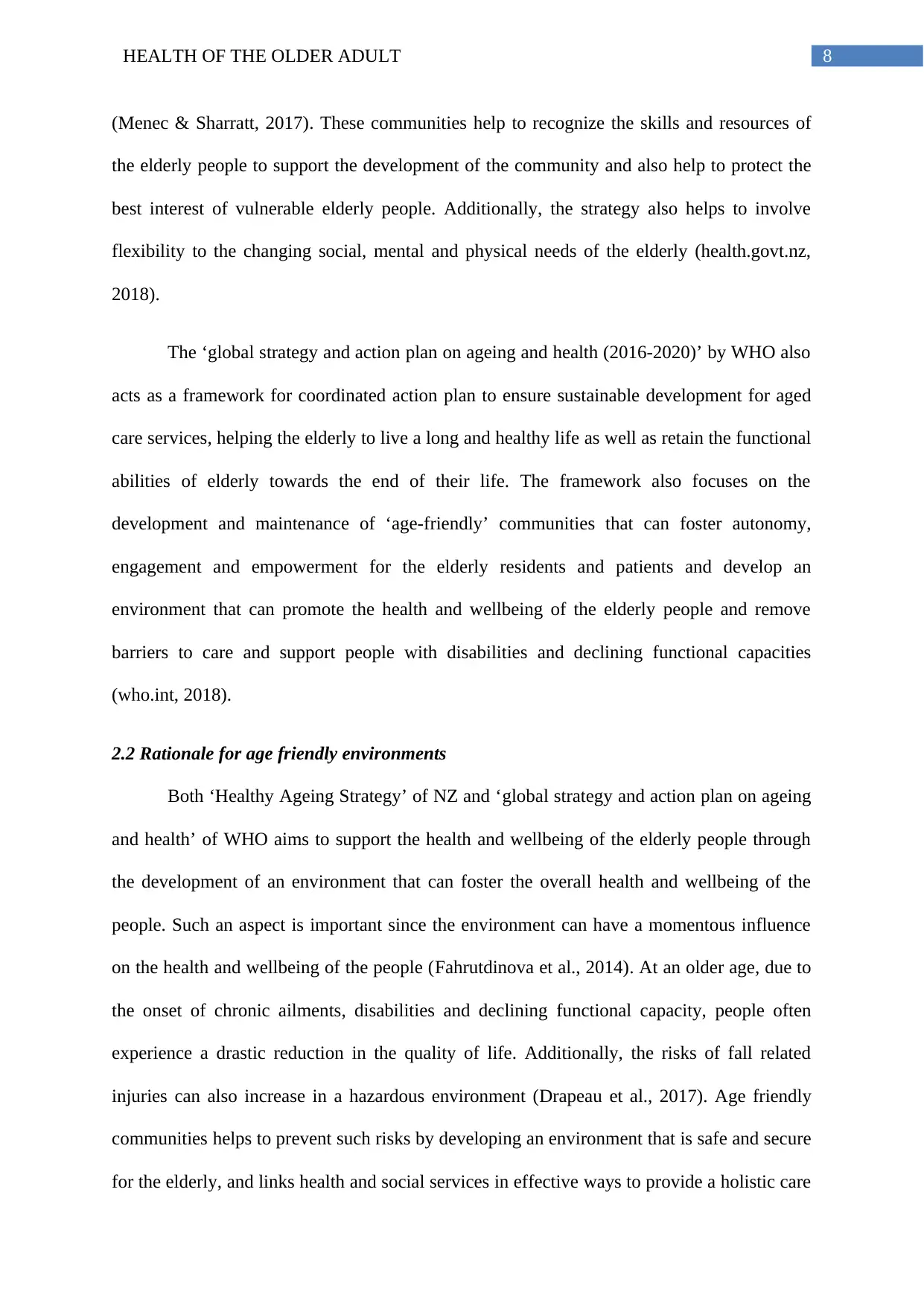
8HEALTH OF THE OLDER ADULT
(Menec & Sharratt, 2017). These communities help to recognize the skills and resources of
the elderly people to support the development of the community and also help to protect the
best interest of vulnerable elderly people. Additionally, the strategy also helps to involve
flexibility to the changing social, mental and physical needs of the elderly (health.govt.nz,
2018).
The ‘global strategy and action plan on ageing and health (2016-2020)’ by WHO also
acts as a framework for coordinated action plan to ensure sustainable development for aged
care services, helping the elderly to live a long and healthy life as well as retain the functional
abilities of elderly towards the end of their life. The framework also focuses on the
development and maintenance of ‘age-friendly’ communities that can foster autonomy,
engagement and empowerment for the elderly residents and patients and develop an
environment that can promote the health and wellbeing of the elderly people and remove
barriers to care and support people with disabilities and declining functional capacities
(who.int, 2018).
2.2 Rationale for age friendly environments
Both ‘Healthy Ageing Strategy’ of NZ and ‘global strategy and action plan on ageing
and health’ of WHO aims to support the health and wellbeing of the elderly people through
the development of an environment that can foster the overall health and wellbeing of the
people. Such an aspect is important since the environment can have a momentous influence
on the health and wellbeing of the people (Fahrutdinova et al., 2014). At an older age, due to
the onset of chronic ailments, disabilities and declining functional capacity, people often
experience a drastic reduction in the quality of life. Additionally, the risks of fall related
injuries can also increase in a hazardous environment (Drapeau et al., 2017). Age friendly
communities helps to prevent such risks by developing an environment that is safe and secure
for the elderly, and links health and social services in effective ways to provide a holistic care
(Menec & Sharratt, 2017). These communities help to recognize the skills and resources of
the elderly people to support the development of the community and also help to protect the
best interest of vulnerable elderly people. Additionally, the strategy also helps to involve
flexibility to the changing social, mental and physical needs of the elderly (health.govt.nz,
2018).
The ‘global strategy and action plan on ageing and health (2016-2020)’ by WHO also
acts as a framework for coordinated action plan to ensure sustainable development for aged
care services, helping the elderly to live a long and healthy life as well as retain the functional
abilities of elderly towards the end of their life. The framework also focuses on the
development and maintenance of ‘age-friendly’ communities that can foster autonomy,
engagement and empowerment for the elderly residents and patients and develop an
environment that can promote the health and wellbeing of the elderly people and remove
barriers to care and support people with disabilities and declining functional capacities
(who.int, 2018).
2.2 Rationale for age friendly environments
Both ‘Healthy Ageing Strategy’ of NZ and ‘global strategy and action plan on ageing
and health’ of WHO aims to support the health and wellbeing of the elderly people through
the development of an environment that can foster the overall health and wellbeing of the
people. Such an aspect is important since the environment can have a momentous influence
on the health and wellbeing of the people (Fahrutdinova et al., 2014). At an older age, due to
the onset of chronic ailments, disabilities and declining functional capacity, people often
experience a drastic reduction in the quality of life. Additionally, the risks of fall related
injuries can also increase in a hazardous environment (Drapeau et al., 2017). Age friendly
communities helps to prevent such risks by developing an environment that is safe and secure
for the elderly, and links health and social services in effective ways to provide a holistic care
⊘ This is a preview!⊘
Do you want full access?
Subscribe today to unlock all pages.

Trusted by 1+ million students worldwide
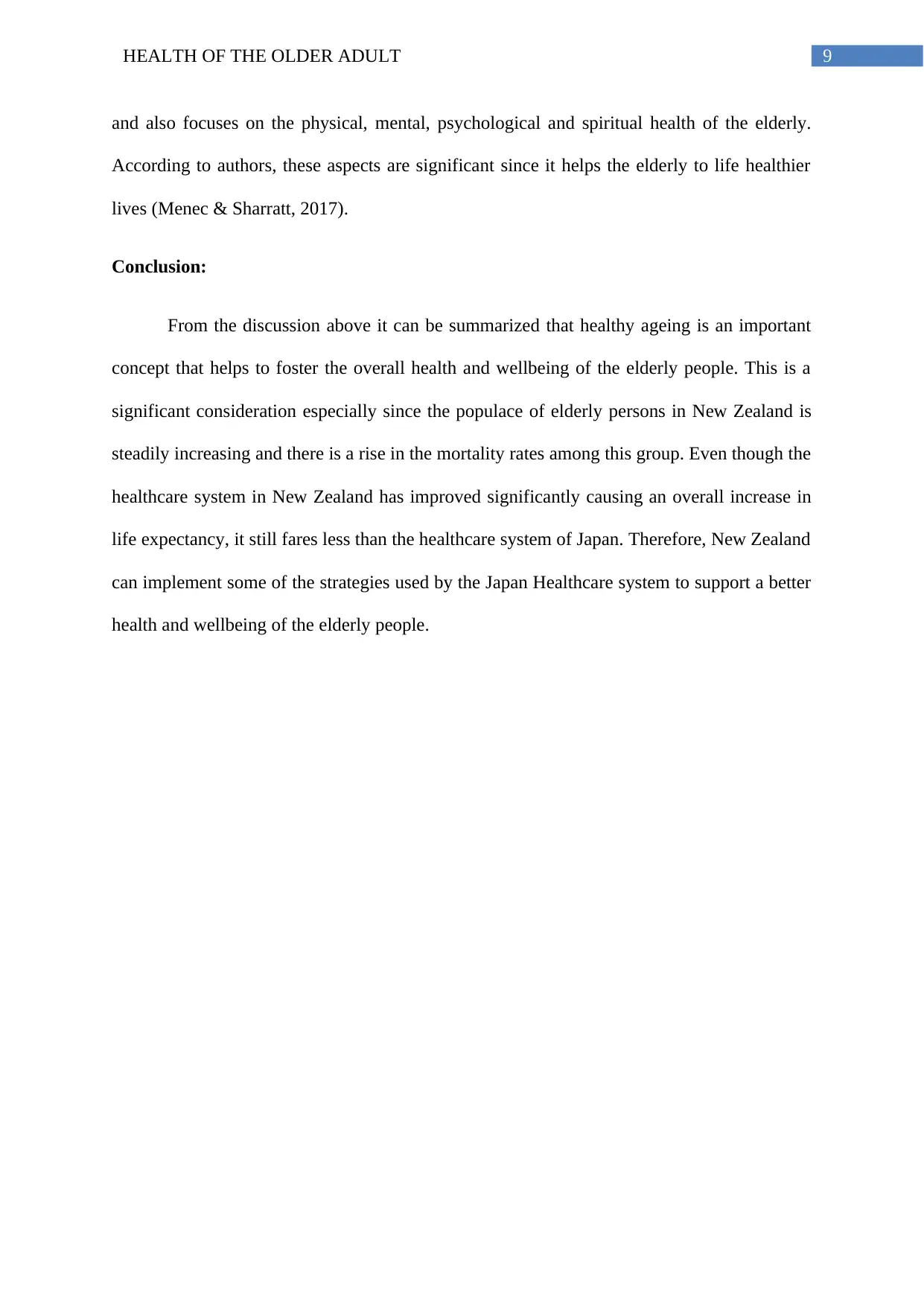
9HEALTH OF THE OLDER ADULT
and also focuses on the physical, mental, psychological and spiritual health of the elderly.
According to authors, these aspects are significant since it helps the elderly to life healthier
lives (Menec & Sharratt, 2017).
Conclusion:
From the discussion above it can be summarized that healthy ageing is an important
concept that helps to foster the overall health and wellbeing of the elderly people. This is a
significant consideration especially since the populace of elderly persons in New Zealand is
steadily increasing and there is a rise in the mortality rates among this group. Even though the
healthcare system in New Zealand has improved significantly causing an overall increase in
life expectancy, it still fares less than the healthcare system of Japan. Therefore, New Zealand
can implement some of the strategies used by the Japan Healthcare system to support a better
health and wellbeing of the elderly people.
and also focuses on the physical, mental, psychological and spiritual health of the elderly.
According to authors, these aspects are significant since it helps the elderly to life healthier
lives (Menec & Sharratt, 2017).
Conclusion:
From the discussion above it can be summarized that healthy ageing is an important
concept that helps to foster the overall health and wellbeing of the elderly people. This is a
significant consideration especially since the populace of elderly persons in New Zealand is
steadily increasing and there is a rise in the mortality rates among this group. Even though the
healthcare system in New Zealand has improved significantly causing an overall increase in
life expectancy, it still fares less than the healthcare system of Japan. Therefore, New Zealand
can implement some of the strategies used by the Japan Healthcare system to support a better
health and wellbeing of the elderly people.
Paraphrase This Document
Need a fresh take? Get an instant paraphrase of this document with our AI Paraphraser
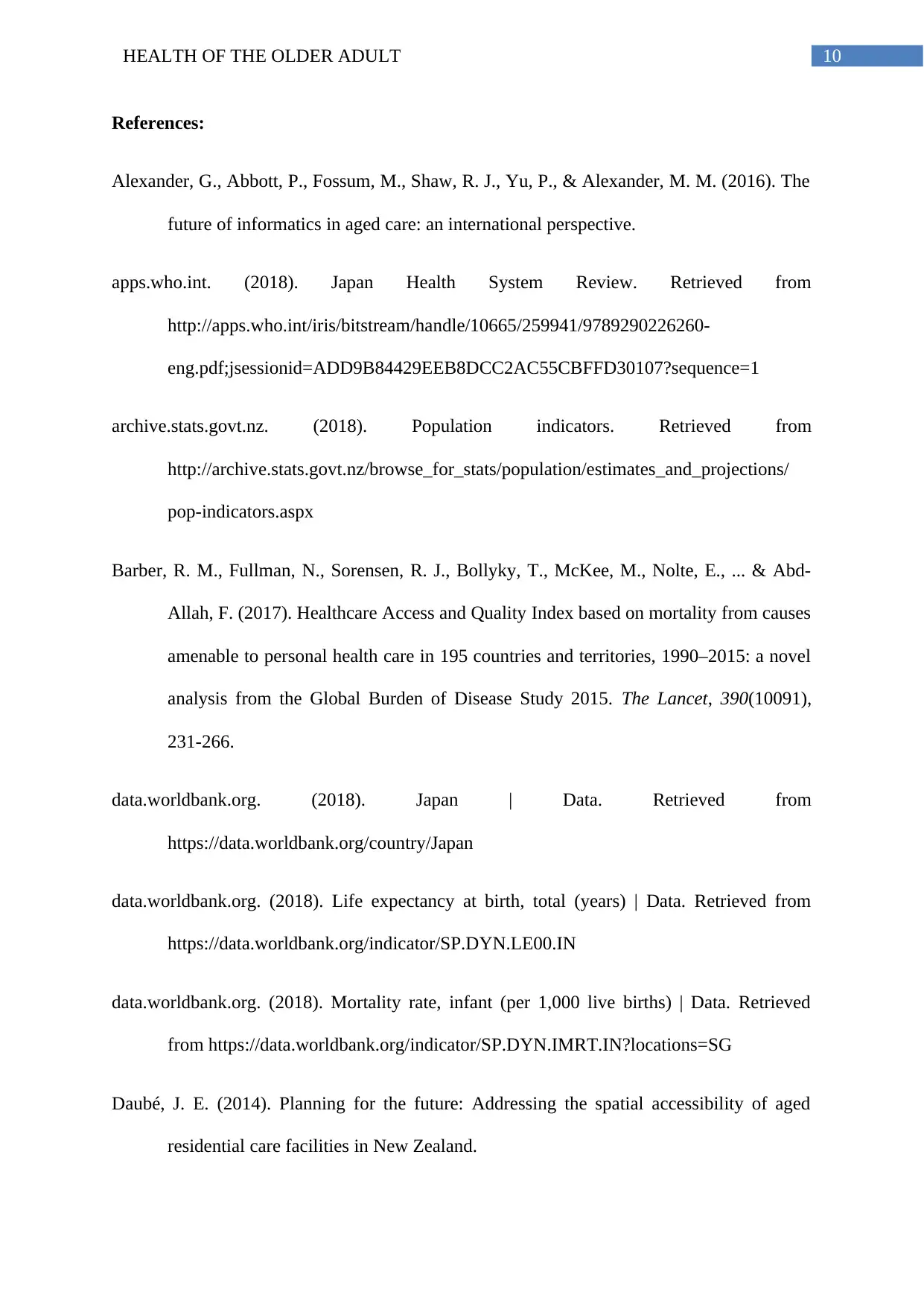
10HEALTH OF THE OLDER ADULT
References:
Alexander, G., Abbott, P., Fossum, M., Shaw, R. J., Yu, P., & Alexander, M. M. (2016). The
future of informatics in aged care: an international perspective.
apps.who.int. (2018). Japan Health System Review. Retrieved from
http://apps.who.int/iris/bitstream/handle/10665/259941/9789290226260-
eng.pdf;jsessionid=ADD9B84429EEB8DCC2AC55CBFFD30107?sequence=1
archive.stats.govt.nz. (2018). Population indicators. Retrieved from
http://archive.stats.govt.nz/browse_for_stats/population/estimates_and_projections/
pop-indicators.aspx
Barber, R. M., Fullman, N., Sorensen, R. J., Bollyky, T., McKee, M., Nolte, E., ... & Abd-
Allah, F. (2017). Healthcare Access and Quality Index based on mortality from causes
amenable to personal health care in 195 countries and territories, 1990–2015: a novel
analysis from the Global Burden of Disease Study 2015. The Lancet, 390(10091),
231-266.
data.worldbank.org. (2018). Japan | Data. Retrieved from
https://data.worldbank.org/country/Japan
data.worldbank.org. (2018). Life expectancy at birth, total (years) | Data. Retrieved from
https://data.worldbank.org/indicator/SP.DYN.LE00.IN
data.worldbank.org. (2018). Mortality rate, infant (per 1,000 live births) | Data. Retrieved
from https://data.worldbank.org/indicator/SP.DYN.IMRT.IN?locations=SG
Daubé, J. E. (2014). Planning for the future: Addressing the spatial accessibility of aged
residential care facilities in New Zealand.
References:
Alexander, G., Abbott, P., Fossum, M., Shaw, R. J., Yu, P., & Alexander, M. M. (2016). The
future of informatics in aged care: an international perspective.
apps.who.int. (2018). Japan Health System Review. Retrieved from
http://apps.who.int/iris/bitstream/handle/10665/259941/9789290226260-
eng.pdf;jsessionid=ADD9B84429EEB8DCC2AC55CBFFD30107?sequence=1
archive.stats.govt.nz. (2018). Population indicators. Retrieved from
http://archive.stats.govt.nz/browse_for_stats/population/estimates_and_projections/
pop-indicators.aspx
Barber, R. M., Fullman, N., Sorensen, R. J., Bollyky, T., McKee, M., Nolte, E., ... & Abd-
Allah, F. (2017). Healthcare Access and Quality Index based on mortality from causes
amenable to personal health care in 195 countries and territories, 1990–2015: a novel
analysis from the Global Burden of Disease Study 2015. The Lancet, 390(10091),
231-266.
data.worldbank.org. (2018). Japan | Data. Retrieved from
https://data.worldbank.org/country/Japan
data.worldbank.org. (2018). Life expectancy at birth, total (years) | Data. Retrieved from
https://data.worldbank.org/indicator/SP.DYN.LE00.IN
data.worldbank.org. (2018). Mortality rate, infant (per 1,000 live births) | Data. Retrieved
from https://data.worldbank.org/indicator/SP.DYN.IMRT.IN?locations=SG
Daubé, J. E. (2014). Planning for the future: Addressing the spatial accessibility of aged
residential care facilities in New Zealand.
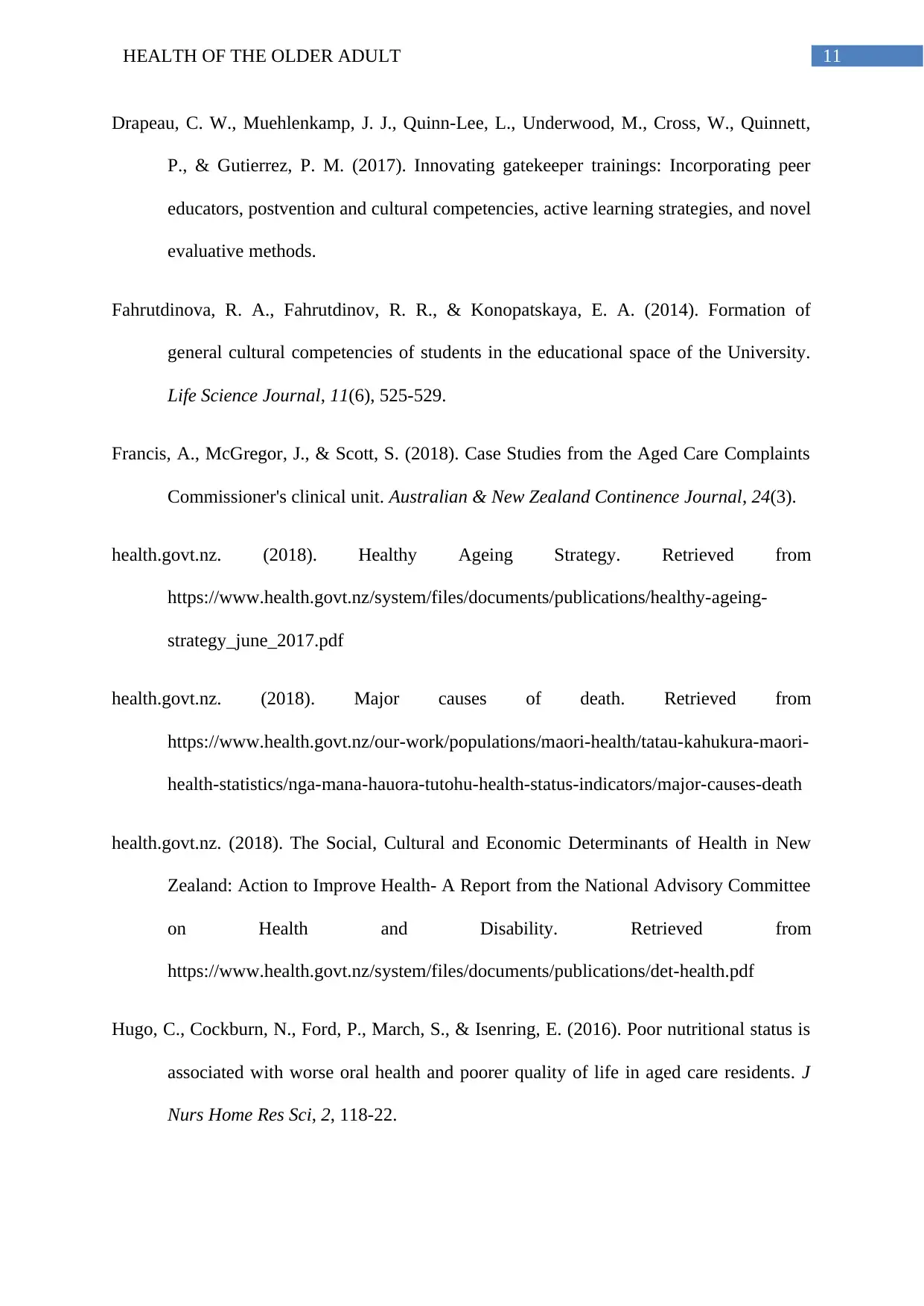
11HEALTH OF THE OLDER ADULT
Drapeau, C. W., Muehlenkamp, J. J., Quinn-Lee, L., Underwood, M., Cross, W., Quinnett,
P., & Gutierrez, P. M. (2017). Innovating gatekeeper trainings: Incorporating peer
educators, postvention and cultural competencies, active learning strategies, and novel
evaluative methods.
Fahrutdinova, R. A., Fahrutdinov, R. R., & Konopatskaya, E. A. (2014). Formation of
general cultural competencies of students in the educational space of the University.
Life Science Journal, 11(6), 525-529.
Francis, A., McGregor, J., & Scott, S. (2018). Case Studies from the Aged Care Complaints
Commissioner's clinical unit. Australian & New Zealand Continence Journal, 24(3).
health.govt.nz. (2018). Healthy Ageing Strategy. Retrieved from
https://www.health.govt.nz/system/files/documents/publications/healthy-ageing-
strategy_june_2017.pdf
health.govt.nz. (2018). Major causes of death. Retrieved from
https://www.health.govt.nz/our-work/populations/maori-health/tatau-kahukura-maori-
health-statistics/nga-mana-hauora-tutohu-health-status-indicators/major-causes-death
health.govt.nz. (2018). The Social, Cultural and Economic Determinants of Health in New
Zealand: Action to Improve Health- A Report from the National Advisory Committee
on Health and Disability. Retrieved from
https://www.health.govt.nz/system/files/documents/publications/det-health.pdf
Hugo, C., Cockburn, N., Ford, P., March, S., & Isenring, E. (2016). Poor nutritional status is
associated with worse oral health and poorer quality of life in aged care residents. J
Nurs Home Res Sci, 2, 118-22.
Drapeau, C. W., Muehlenkamp, J. J., Quinn-Lee, L., Underwood, M., Cross, W., Quinnett,
P., & Gutierrez, P. M. (2017). Innovating gatekeeper trainings: Incorporating peer
educators, postvention and cultural competencies, active learning strategies, and novel
evaluative methods.
Fahrutdinova, R. A., Fahrutdinov, R. R., & Konopatskaya, E. A. (2014). Formation of
general cultural competencies of students in the educational space of the University.
Life Science Journal, 11(6), 525-529.
Francis, A., McGregor, J., & Scott, S. (2018). Case Studies from the Aged Care Complaints
Commissioner's clinical unit. Australian & New Zealand Continence Journal, 24(3).
health.govt.nz. (2018). Healthy Ageing Strategy. Retrieved from
https://www.health.govt.nz/system/files/documents/publications/healthy-ageing-
strategy_june_2017.pdf
health.govt.nz. (2018). Major causes of death. Retrieved from
https://www.health.govt.nz/our-work/populations/maori-health/tatau-kahukura-maori-
health-statistics/nga-mana-hauora-tutohu-health-status-indicators/major-causes-death
health.govt.nz. (2018). The Social, Cultural and Economic Determinants of Health in New
Zealand: Action to Improve Health- A Report from the National Advisory Committee
on Health and Disability. Retrieved from
https://www.health.govt.nz/system/files/documents/publications/det-health.pdf
Hugo, C., Cockburn, N., Ford, P., March, S., & Isenring, E. (2016). Poor nutritional status is
associated with worse oral health and poorer quality of life in aged care residents. J
Nurs Home Res Sci, 2, 118-22.
⊘ This is a preview!⊘
Do you want full access?
Subscribe today to unlock all pages.

Trusted by 1+ million students worldwide
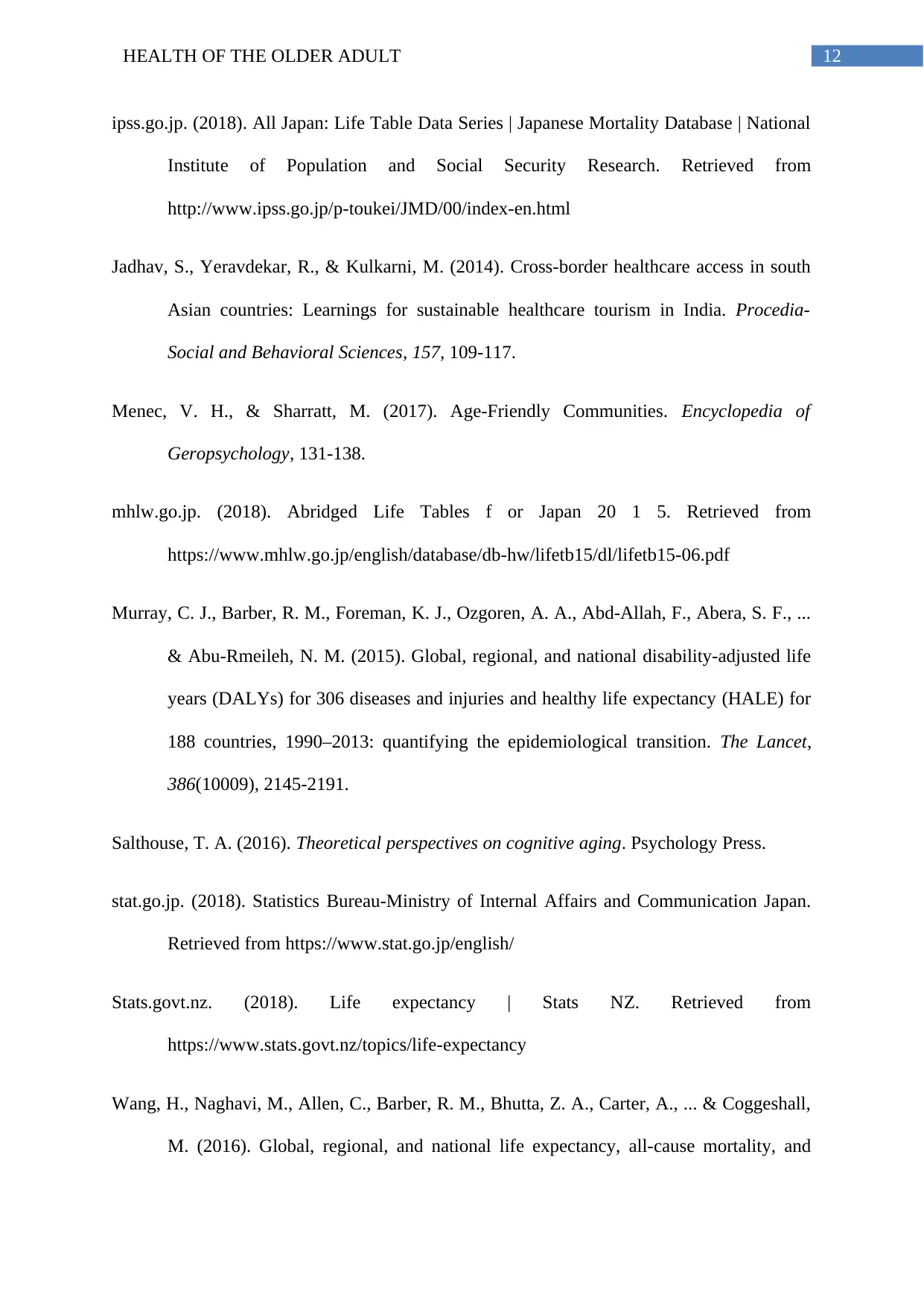
12HEALTH OF THE OLDER ADULT
ipss.go.jp. (2018). All Japan: Life Table Data Series | Japanese Mortality Database | National
Institute of Population and Social Security Research. Retrieved from
http://www.ipss.go.jp/p-toukei/JMD/00/index-en.html
Jadhav, S., Yeravdekar, R., & Kulkarni, M. (2014). Cross-border healthcare access in south
Asian countries: Learnings for sustainable healthcare tourism in India. Procedia-
Social and Behavioral Sciences, 157, 109-117.
Menec, V. H., & Sharratt, M. (2017). Age-Friendly Communities. Encyclopedia of
Geropsychology, 131-138.
mhlw.go.jp. (2018). Abridged Life Tables f or Japan 20 1 5. Retrieved from
https://www.mhlw.go.jp/english/database/db-hw/lifetb15/dl/lifetb15-06.pdf
Murray, C. J., Barber, R. M., Foreman, K. J., Ozgoren, A. A., Abd-Allah, F., Abera, S. F., ...
& Abu-Rmeileh, N. M. (2015). Global, regional, and national disability-adjusted life
years (DALYs) for 306 diseases and injuries and healthy life expectancy (HALE) for
188 countries, 1990–2013: quantifying the epidemiological transition. The Lancet,
386(10009), 2145-2191.
Salthouse, T. A. (2016). Theoretical perspectives on cognitive aging. Psychology Press.
stat.go.jp. (2018). Statistics Bureau-Ministry of Internal Affairs and Communication Japan.
Retrieved from https://www.stat.go.jp/english/
Stats.govt.nz. (2018). Life expectancy | Stats NZ. Retrieved from
https://www.stats.govt.nz/topics/life-expectancy
Wang, H., Naghavi, M., Allen, C., Barber, R. M., Bhutta, Z. A., Carter, A., ... & Coggeshall,
M. (2016). Global, regional, and national life expectancy, all-cause mortality, and
ipss.go.jp. (2018). All Japan: Life Table Data Series | Japanese Mortality Database | National
Institute of Population and Social Security Research. Retrieved from
http://www.ipss.go.jp/p-toukei/JMD/00/index-en.html
Jadhav, S., Yeravdekar, R., & Kulkarni, M. (2014). Cross-border healthcare access in south
Asian countries: Learnings for sustainable healthcare tourism in India. Procedia-
Social and Behavioral Sciences, 157, 109-117.
Menec, V. H., & Sharratt, M. (2017). Age-Friendly Communities. Encyclopedia of
Geropsychology, 131-138.
mhlw.go.jp. (2018). Abridged Life Tables f or Japan 20 1 5. Retrieved from
https://www.mhlw.go.jp/english/database/db-hw/lifetb15/dl/lifetb15-06.pdf
Murray, C. J., Barber, R. M., Foreman, K. J., Ozgoren, A. A., Abd-Allah, F., Abera, S. F., ...
& Abu-Rmeileh, N. M. (2015). Global, regional, and national disability-adjusted life
years (DALYs) for 306 diseases and injuries and healthy life expectancy (HALE) for
188 countries, 1990–2013: quantifying the epidemiological transition. The Lancet,
386(10009), 2145-2191.
Salthouse, T. A. (2016). Theoretical perspectives on cognitive aging. Psychology Press.
stat.go.jp. (2018). Statistics Bureau-Ministry of Internal Affairs and Communication Japan.
Retrieved from https://www.stat.go.jp/english/
Stats.govt.nz. (2018). Life expectancy | Stats NZ. Retrieved from
https://www.stats.govt.nz/topics/life-expectancy
Wang, H., Naghavi, M., Allen, C., Barber, R. M., Bhutta, Z. A., Carter, A., ... & Coggeshall,
M. (2016). Global, regional, and national life expectancy, all-cause mortality, and
Paraphrase This Document
Need a fresh take? Get an instant paraphrase of this document with our AI Paraphraser
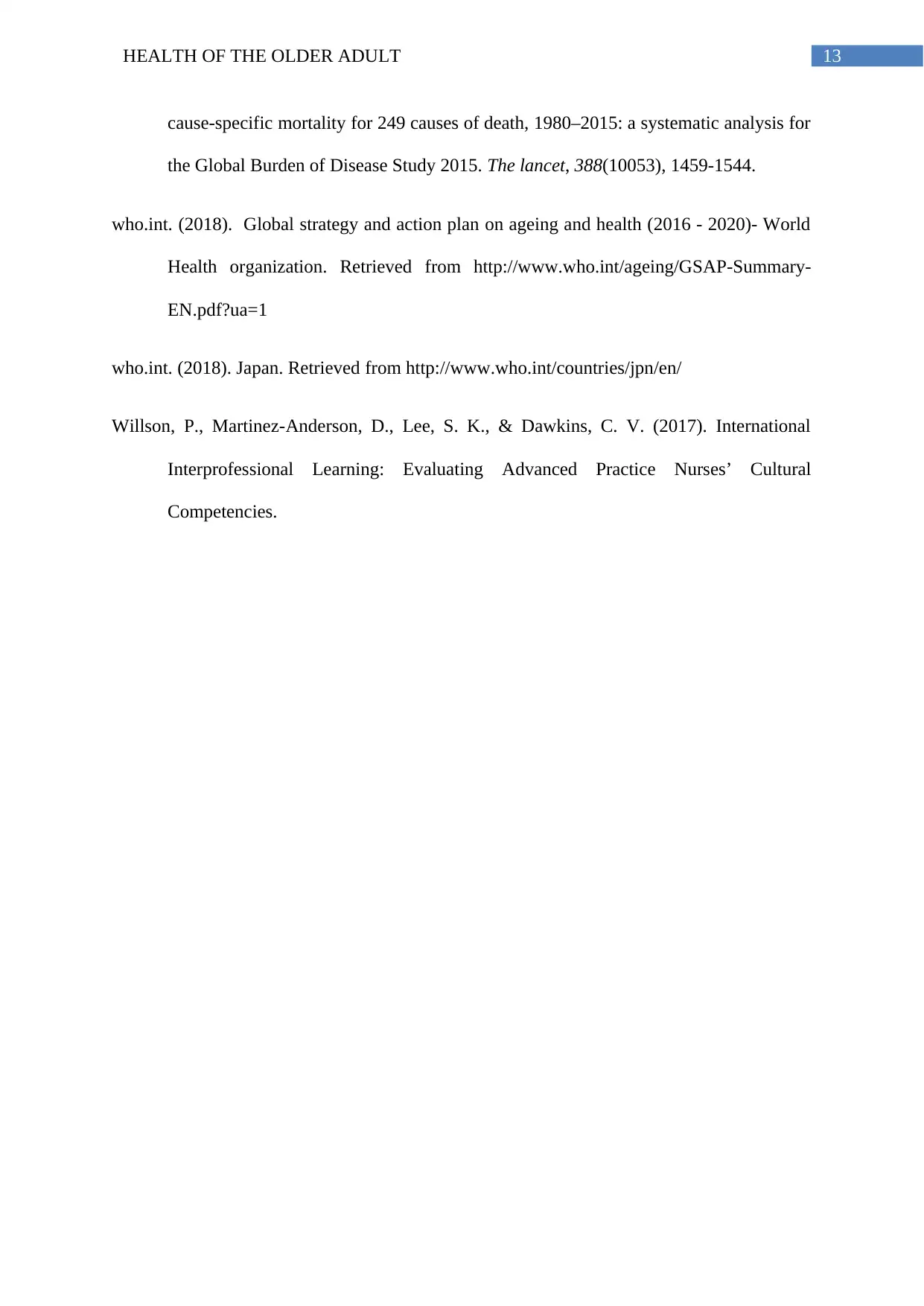
13HEALTH OF THE OLDER ADULT
cause-specific mortality for 249 causes of death, 1980–2015: a systematic analysis for
the Global Burden of Disease Study 2015. The lancet, 388(10053), 1459-1544.
who.int. (2018). Global strategy and action plan on ageing and health (2016 - 2020)- World
Health organization. Retrieved from http://www.who.int/ageing/GSAP-Summary-
EN.pdf?ua=1
who.int. (2018). Japan. Retrieved from http://www.who.int/countries/jpn/en/
Willson, P., Martinez-Anderson, D., Lee, S. K., & Dawkins, C. V. (2017). International
Interprofessional Learning: Evaluating Advanced Practice Nurses’ Cultural
Competencies.
cause-specific mortality for 249 causes of death, 1980–2015: a systematic analysis for
the Global Burden of Disease Study 2015. The lancet, 388(10053), 1459-1544.
who.int. (2018). Global strategy and action plan on ageing and health (2016 - 2020)- World
Health organization. Retrieved from http://www.who.int/ageing/GSAP-Summary-
EN.pdf?ua=1
who.int. (2018). Japan. Retrieved from http://www.who.int/countries/jpn/en/
Willson, P., Martinez-Anderson, D., Lee, S. K., & Dawkins, C. V. (2017). International
Interprofessional Learning: Evaluating Advanced Practice Nurses’ Cultural
Competencies.
1 out of 14
Related Documents
Your All-in-One AI-Powered Toolkit for Academic Success.
+13062052269
info@desklib.com
Available 24*7 on WhatsApp / Email
![[object Object]](/_next/static/media/star-bottom.7253800d.svg)
Unlock your academic potential
© 2024 | Zucol Services PVT LTD | All rights reserved.





